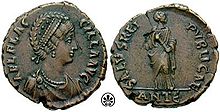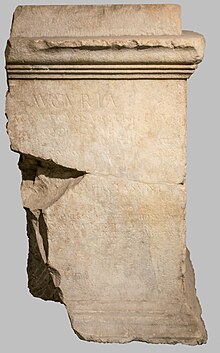Salus (mythology)
In the Roman religion, salus is the personification of well-being (Latin salus = well-being, well-being, salvation, security, health). The female deity was usually depicted enthroned with a scepter , bowl, snake or with ears of corn. Salus was primarily associated with the well-being and security of the Roman state, its inhabitants and, during the imperial era, also the rulers. Accordingly, the deity was also referred to as Salus publica or Salus populi Romani .
In the oldest Roman history, the festival of Salus was celebrated as Augurium Salutis first every year, then at irregular intervals . Gaius Junius Bubulcus Brutus vowed 311 BC During the second Samnite war the construction of a Salus temple, which was built in 307 BC. And on August 5, 302 BC. On which Collis Quirinalis was consecrated. There may have been an older Salus cult on this hill before.
Salus was often worshiped in connection with Semonia and can therefore probably also be regarded as the seed goddess. Influenced by Greek- Hellenistic models and connected with the introduction of the Aesculapian cult, Salus was established in the 2nd century BC. BC also associated with the Greek goddess of healing Hygieia , but did not lose her character as the general patron goddess of the Roman state. Augustus still built 10 BC. The Salus populi Romani built an altar.
In Augustan times, the feast of Augurium Salutatis was celebrated in honor of the emperor. A corresponding festival of the emperor Claudius is attested for the year 49. The goddess was widely worshiped as Salus Augusta as the goddess of state and imperial well-being. Especially under Galba and Vespasian there was a new renaissance of this cult, but now as a sign of the state restoration after the rule of the emperors of the Julio-Claudian dynasty . Up until the time of Hadrian , depictions of the Salus in connection with the well-being of the provinces as part of the empire are also frequently found . These were particularly common in Lusitania and Baetica .
literature
- Georg Wissowa : Salus . In: Wilhelm Heinrich Roscher (Hrsg.): Detailed lexicon of Greek and Roman mythology . Volume 4, Leipzig 1915, Col. 295-301 ( digitized version ).
- Carl Olof Thulin : Salus 1. In: Paulys Realencyclopadie der classischen Antiquity Science (RE). Volume IA, 2, Stuttgart 1920, Sp. 2057-2059.
- Karlhans Abel : Salus. In: The Little Pauly (KlP). Volume 4, Stuttgart 1972, Sp. 1522 f.
- Martin A. Marwood: The Roman cult of Salus. Oxford 1988 ( British archaeological reports, International series 465).
- Vincenzo Saladino: Salus . In: Lexicon Iconographicum Mythologiae Classicae (LIMC). Volume VII, Zurich / Munich 1994, pp. 656-661.
- Lorenz Winkler-Horaček : Salus. From state cult to political idea. An archaeological investigation. Heidelberg 1995 (Archeology and History 4).
- David Wardle: Salus. In: The New Pauly (DNP). Volume 10, Metzler, Stuttgart 2001, ISBN 3-476-01480-0 , Sp. 1268 f.
Web links
- Salus. In: imperiumromanum.com → Ancient Religion. Retrieved June 16, 2012 .
Remarks
- ↑ Titus Livius 10, 1, 9 .
- ^ Marcus Terentius Varro , De lingua Latina 5, 52 .
- ↑ Ovid , Fasti 3, 881-882 ; Cassius Dio 54, 35, 2 ( English translation ).
- ↑ CIL 6, 36841
- ↑ Tacitus , Annales 12, 23 .

